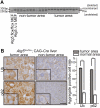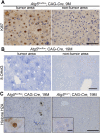Autophagy-deficient mice develop multiple liver tumors
- PMID: 21498569
- PMCID: PMC3078705
- DOI: 10.1101/gad.2016211
Autophagy-deficient mice develop multiple liver tumors
Abstract
Autophagy is a major pathway for degradation of cytoplasmic proteins and organelles, and has been implicated in tumor suppression. Here, we report that mice with systemic mosaic deletion of Atg5 and liver-specific Atg7⁻/⁻ mice develop benign liver adenomas. These tumor cells originate autophagy-deficient hepatocytes and show mitochondrial swelling, p62 accumulation, and oxidative stress and genomic damage responses. The size of the Atg7⁻/⁻ liver tumors is reduced by simultaneous deletion of p62. These results suggest that autophagy is important for the suppression of spontaneous tumorigenesis through a cell-intrinsic mechanism, particularly in the liver, and that p62 accumulation contributes to tumor progression.
Figures





References
-
- Cadet J, Douki T, Gasparutto D, Ravanat JL 2003. Oxidative damage to DNA: formation, measurement and biochemical features. Mutat Res 531: 5–23 - PubMed
Publication types
MeSH terms
Substances
LinkOut - more resources
Full Text Sources
Other Literature Sources
Medical
Molecular Biology Databases
